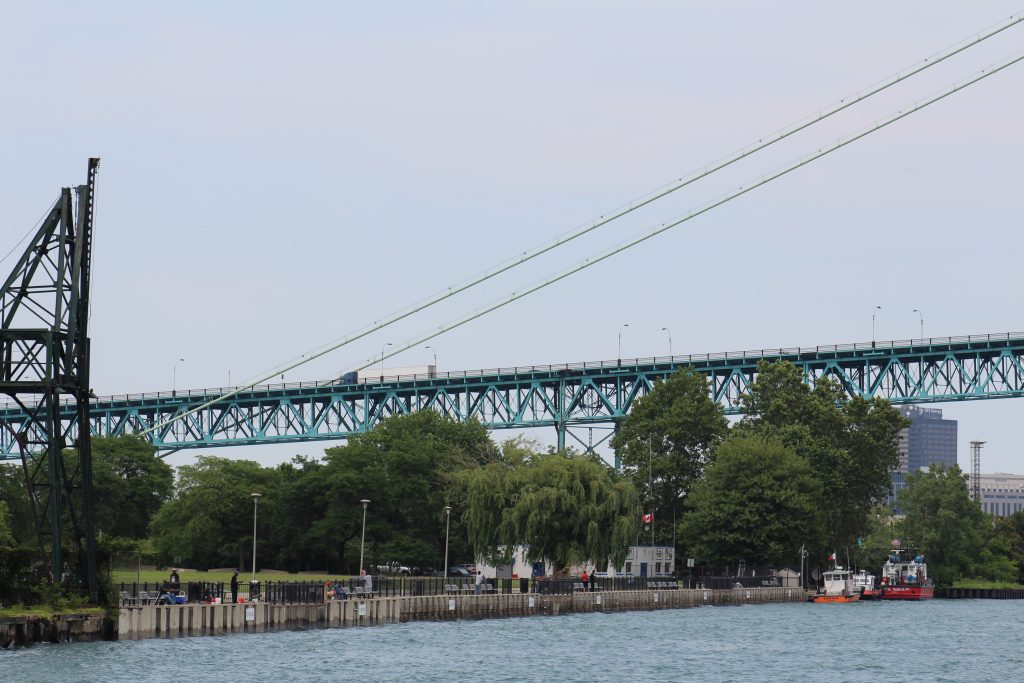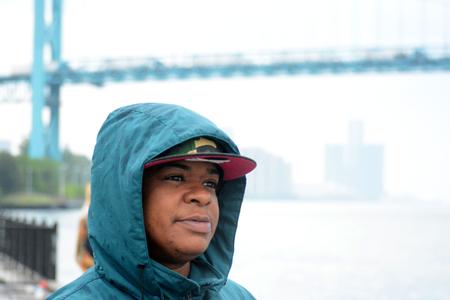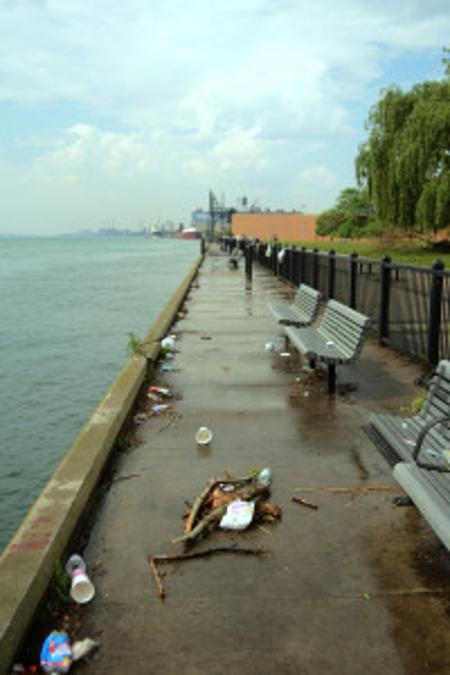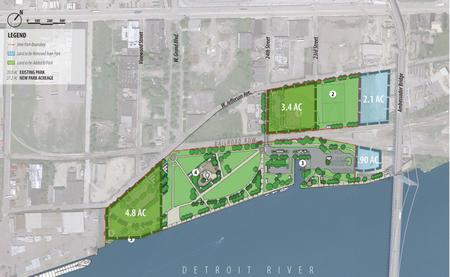Understanding Riverside Park
Detroit’s Riverside Park is at the heart of a debate over a proposed land swap. Learn about the back-story here.


Detroit’s Riverside Park is at the heart of an ongoing debate between city hall, local residents and the Detroit International Bridge Company, owner of the Ambassador Bridge. The City Council is set to vote within weeks on a controversial “land swap” deal proposed by Mayor Mike Duggan, which would, in part, turn over parts of the park to the Bridge Company. For nearly 15 years, the DIBC, led by the controversial Manuel “Matty” Moroun, has used illegal fencing, claims of toxic contamination, court appeals and other stall tactics to commandeer the space, one of just a few public parks in the city on the Detroit River. Moroun, a billionaire trucking mogul, wants to build a “twin” span to his existing Ambassador Bridge. The “land swap” agreement with the DIBC is drawing both support and consternation in the community.Here, we bring you the facts behind the proposal and some background about Riverside Park, including the voices of residents.
Welcome to Riverside Park
With its sweeping views of the Detroit River, city skyline and the Ambassador Bridge, Riverside Park is one of the most impressive — yet underutilized — waterfront parks in the city.
Its roughly 20 acres contain three land parcels. Two include the riverside promenade and boat launch at the foot of West Grand Boulevard. A third houses multipurpose fields and baseball diamonds.
With 1,500 feet of shoreline at the river’s narrowest point, Riverside is not only a prime fishing spot, but also an ideal location to take in the impressive freighter traffic that traverses the Detroit River. Adding to its novelty, Riverside’s neighbor is the J.W. Westcott, a floating post office that has delivered mail and supplies to Great Lakes commercial vessels via rope-and-bucket since 1874.

Gregory Welch, a lifelong eastsider, comes to Riverside Park every summer to fish along the promenade. Crappies and walleyes are among his favorites, which he recommends either fried or oven-baked. He shares most of his catches with others. He’s not sure of the details of the proposed land exchange agreement, but says he is “all in” for more city investment in the park.
“I’ve been fishing here all my life,” Welch says. “I normally come when the summer bass are running. I remember the park looked better in better days. When they had the bathroom and the swings . . . We used to take our bikes down here. I grew up on the Eastside down the street from here. I used to be a hustler. I used to sell worms, peanuts, sinkers, me and my little three brothers. My dad would bring us down here and we’d make a day out of it.”
In spite of its unique features and rich history, a visit to Riverside Park can be described as underwhelming.

Today, the park lacks access to any type of playscapes or restrooms, and the majority of its green space is overgrown. The waterfront promenade can feature more litter than fishermen, and trash has been seen erupting from garbage cans like lava from urban volcanoes.
The ball diamond that once teemed with community leagues is barely visible under a cloak of vegetation, and the formerly active boat launch is also closed off to the public. Even less inviting are the chainlink fences and signposts that ward off entry to the park’s greenways due to fears of hazardous contamination.
Although the park could seem to have been long-forgotten by the city, it looms large in the mind of local residents. Some visitors have fond memories of Riverside’s early history, and others have bitter reactions to the complex business and political dealings that have inhibited the park’s use during the past 15 years.
A Brief History of Riverside Park
Understanding the Land Swap Deal

Who Gets What?
The City of Detroit Would Receive:
Additional Park Land: 4.8 acres on the western edge of the existing park, dubbed the “Newspaper Warehouse Building Property,” which will be razed by the DIBC in 2018 when their current tenant’s lease expires. The land is southwest (to the left) of Parcel 3 in the above map.
Park Funding: The DIBC gives the city $3 million to fund the transformation of 3.4 acres of currently city-owned property into park land. The land is located to the southwest (left) of Parcel 1 in the above map. Various upgrades would be included, and construction would begin this fall. Plans include a new baseball diamond, soccer field and multi-use play areas, a riverfront playscape, new benches, picnic tables and shelter, and an improved waterfront promenade and landscaping.
The Possibility of Additional Funding: If state and federal agencies approve the city’s 3-acre land transfer to the bridge company, the company will give the city an additional $2 million to the city for the creation of a “Fisherman’s Overlook,” which will include:
- Improvements to the seawall
- New sidewalks and benches
- An extended promenade. It would be located on the land southwest of Parcel 3 in the above map.
- Improvements to the Blighted Michigan Central Station: As part of the deal, DIBC pledges to install 1,050 windows in Corktown’s infamously blighted train depot by the end of 2015. The Bridge Company owns the property.

The Detroit International Bridge Company Would Receive:
Park Land: Detroit will transfer 3 acres on Riverside Park’s eastern edge, part of Parcels 1 and 2 in the above map, to the Detroit International Bridge Company, which the company will use in potential construction of a twin span to the existing Ambassador Bridge.
Unwavering City Support: For potentially 25 years, the city will be contractually obligated to cooperate with the DIBC in obtaining all approvals and authorizations from governmental authorities during the land conversion process, as well as vigorously defending any lawsuits that arise.
What’s Next?
The City-Bridge Company land exchange agreement awaits a vote by the Detroit City Council, tentatively scheduled for July 14.
On June 29, a council committee held a community meeting that allowed Detroit residents to publicly comment on the deal. With council members Scott Benson, Gabe Leland and Brenda Jones in attendance, Council Member Raquel Castaneda-Lopez led the meeting. City council has sought the expert opinion of their Legislative Policy Division, which has urged caution in the matter. If the council votes no, Mayor Duggan holds veto power that would bring the measure back to council a second time. During a second vote, a two-thirds majority of the 9-member council would be needed in order to approve the agreement.
Documents:
Legislative Review of Land Agreement
The Proposed Deal Needs State and Federal Approval
The Land Exchange Agreement is also subject to both state and federal approval, as Riverside Park is encumbered in perpetuity for public outdoor recreation. Dating back nearly 30 years, the city has received several grants that have aided the city in acquiring and developing the park land. These includes funds from the Michigan Department of Natural Resources, the Land and Water Conservation Fund ($807,176 in 1976), the Michigan Natural Resources Trust Fund ($500,000 in 1997) and the Waterways Program ($154,000 in 2010).
As the city seeks to convert the Riverside Park land to non-recreational use, there is a wealth of information—such as appraisals of market value and recreational usefulness—that the city of Detroit must provide to the state when applying for the land conversion. Once the Michigan DNR has the application, it reviews it for completeness and eligibility before sending it on to the National Park Service office in Omaha, Nebraska for further review.
The approval process takes about six months to a year for non-complex proposals, says Jon Mayes of MDNR’s Grants Management Section. The Riverside Park deal, he says, would be considered a complex deal due to the various state and federal grants that have funded the site.
Documents
Letter from MDNR to Mayor Duggan
Land Conversion Process Outline
Questions Remain About Environmental Issues
In March 2012, Riverside Park was closed off due to soil contamination discovered and reported by the DIBC. According to a report from the Michigan Department of Environmental Quality (MDEQ), the contamination, which is buried 8 feet below ground level, consists of hydrocarbons, nickel, chrome, and lead—the result of the site’s former life as a historical gas manufacturing plant. DTE, which merged with former site owner MichCon in 2001, is responsible for cleaning up two of the Riverside parcels, and is currently working in tandem with MDEQ to survey and remediate the contamination.
The ongoing project, which is now in its third year, consists of soil borings, monitoring wells and various forms of sampling to evaluate on-site environmental conditions. Although a report from DTE’s independent toxicologist said the boat launch and playing fields are safe to use, portions of the park remain closed for further investigation and clean-up. The park is expected to re-open by the end of 2015, according to members of city council.
Meet the People of Riverside Park
Angler Patrice Jackson
The ability to fish while admiring the Detroit River and skyline, as framed by the Ambassador Bridge, is one of Riverside Park’s captivating features. The solitary nature of fishing makes the pastime an alluring one for those who are seeking a break from the hustle and bustle of the Motor City. WDET’s Amber Harvey spoke with one such local resident, Patrice Jackson, who comes to the park not only to try her hand at fishing, but also to clear her head. You can listen to their conversation below.
Riverside Poet: Michael Lauchlan
Long before it was inciting public debates and community meetings regarding its uncertain fate, Riverside Park was inspiring poetry. Listen to the 1981 poem “Riverside Park” read by the poet, Michael Lauchlan. WDET’s Amber Harvey spoke with the poet Michael Lauchlan about the inspiration behind his 1981 poem, “Riverside Park,” and his fond memories of the now-contentious space.
Riverside Park
He crosses the last tracks,
pulls into the lot, idles,
kills it and slumps into his hands.
He wakes to the river’s wash.
Children run past the windows,
part, collide, and cross,
quick and luminous–a school of fish.
The gulls treat them so,
laughing in their loud wake,
descending onto their garbage
and then up and out alone
for the secret flashing silver.
The bridge towers over him, over the caught
iron river in the spreading shadow
and hums with crawling taillights
flickering behind cables.
And then a flame
pours from the sky like a serpent
but at the last
jerks its kite face from the river’s teeth,
rises toward home, pulls
just to stay aloft
like an orange queen of birds
or an afterburn at the Rouge Plant
which hovers over the penitent
who shuffle in at dusk.
Michael Lauchlan
From And the Business Goes to Pieces, Fallen Angel Press, Highland Park MI, 1981
(reprinted with permission)
Amber Lois Harvey is WDET’s Special Projects Intern. Read more about her here.
Other contributors:
WDET’s Special Projects Intern Michael Ference, Digital Editor Nina Ignaczak and Special Projects Manager Sandra Svoboda.
